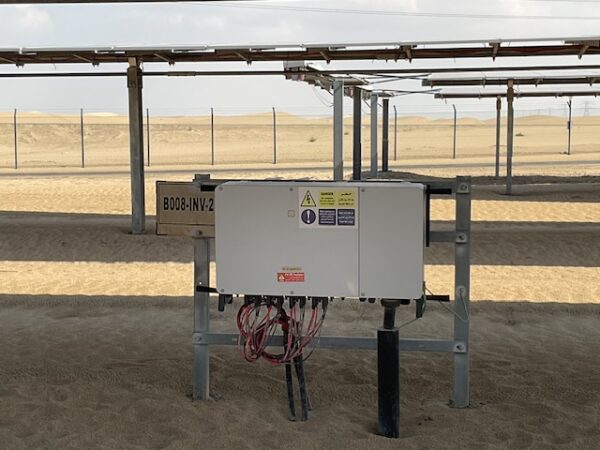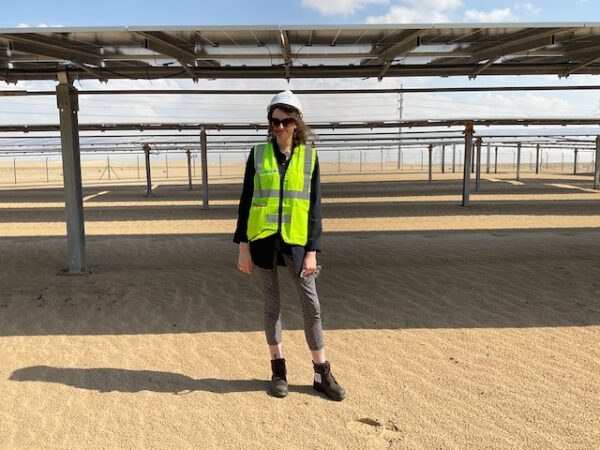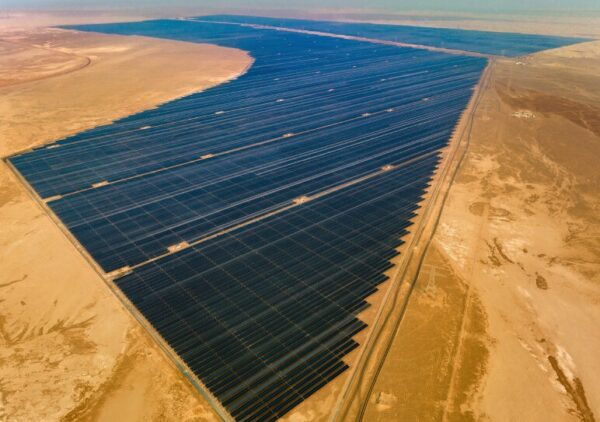The 2 GW Al Dhafra solar park covers an area of 21.5 square km in the sandy outskirts of the suburb Dhafra near Abu Dhabi. pv magazine visited to get the lowdown on the plant’s specs and how it is contributing to the local energy landscape.
It rarely rains in the desert of Abu Dhabi, but the heavens opened when pv magazine visited in January to see the 2 GW Al Dhafra solar park. Local engineers tell us it is the world’s largest single-site solar plant, producing enough energy to power 200,000 homes.
Some of the 3.8 million panels it contains are visible from the visitor center, but there is only so much the human eye can take in.
Luckily, the rain clears up and we get the chance to walk among the panels. The scale of the plant means we must be driven out to the middle of the park. It takes several minutes.

Stepping outside the van, we can hear the noise of the trackers – the panels are mounted on a total of 30,000 trackers.
The trackers have several different modes, including auto-tracking (follows the sun’s path with astronomical algorithm along with backtracking), wind mode (adapts to windy conditions), rain mode (stops at certain angles if it rains), cleaning mode (sets the panels to a specific angle for manual cleaning. The park has 2,000 cleaning robots), and horizontal mode (for maintenance).

Image: pv magazine
Monitoring such a monumental operation is a challenge. It has 20 weather monitoring stations and a million signal data points. Al Dhafra’s engineers rely on 8,000 string inverters which guarantee a high level of uptime. These are made by Sungrow.
The plant has three different module specs, using cells from TrinaSolar, Suntech and Jinko Solar. Trina’s TSM-DEG19C.20 modules come with an efficiency of 21.20%; Suntech’s STPXXXS-C72/Pmh+ modules are 21.30% efficiency; and Jinko Solar’s N-type 72HL4-BDV modules offer an efficiency of 21.87%. All come with 30-year power guarantees.

Inaugurated in November 2023, Al Dhafra is not the newest plant in Abu Dhabi. At the visitors’ center the team tells pv magazine they are building the sixth solar plant currently – Al Dhafra is ’PV2’ in a series of massive utility-scale parks. Each are owned by different shareholders. Emirates Water and Electricity Co. (EWEC) is the procurer.

Image: EWEC
Al Dhafra’s managers, a consortium comprised of French energy giant EDF Renewables, Emirati-state owned investor Masdar, and China’s solar developer Jinko Power are on hand to tell us all about the park’s development, its financing, and the technology supporting its operation.
Masdar Chief Operating Officer Abdulaziz Alobaidli pointed out that the plant’s development took place during the pandemic creating multiple challenges. That said, he explained the engineering team’s perseverance enabled them to stay the course and in one day they added up to 10 MW of capacity.

Masdar, Alobaidli said, is at the forefront of renewable energy technology, with developments in more than 40 countries. “Our portfolio capacity is north of 31 GW, and we have an ambitious target to achieve 100 GW by 2030.”
Will this be possible? Alobaidli is hopeful. “This is a market where you can advance very quickly because a lot of the predevelopment is already done by the government.” Unlike Europe, he means. However, Masdar is “market agnostic”.

CEO of EDF Renewables‘ Middle East Oliver Bordes and Jinko Power’s VP of International Tenders Mothana Qteishat both said their respective companies have been in the Middle East market for around 10 years.
EDF has around 800 people in the region.“We really started to develop our business here in the region maybe 10 years ago, thanks to the IPP renewable market,” said Bordes.

“Since 2015 we have seen around 8 GW of projects in the region. Our first pillar is around developing the utility-scale pipeline, and our second is around proposing solutions to manage the flexibility of the system, to manage intermittency. We propose batteries, pumped hydro, and some pumped storage plants.”
EDF is also an “important player” in helping the grid operator in the UAE to develop and advance its grid. “We are contributing as technical experts every time they do interconnection studies,” he said of the grid operator.
The Middle East is an ideal location for EDF to focus its solar business, its climate is both environmentally and financially hospitable. “This project is a laboratory of what we can do in the real world. So, because there are these large-scale projects, because the market is super competitive, that forces everybody to be super innovative, to work on price … all of that is absolutely key. We need to be in the Middle East because this is the first place we are able to advance and we can be ahead of what is happening.”
Jinko Power is busy participating in multiple tenders for both solar and storage projects in the Middle East, according to Qteishat.
“We have participated in almost all of the major tenders in the region. Our portfolio consists of 5 projects today, Saudi Arabia is another one of our core markets, besides the UAE.”
As Jinko Power, which bears no real relation to Al Dhafra module supplier Jinko Solar, moves into the next decade in the market, the company aims to “keep creating on a megascale” Qteishat said.
